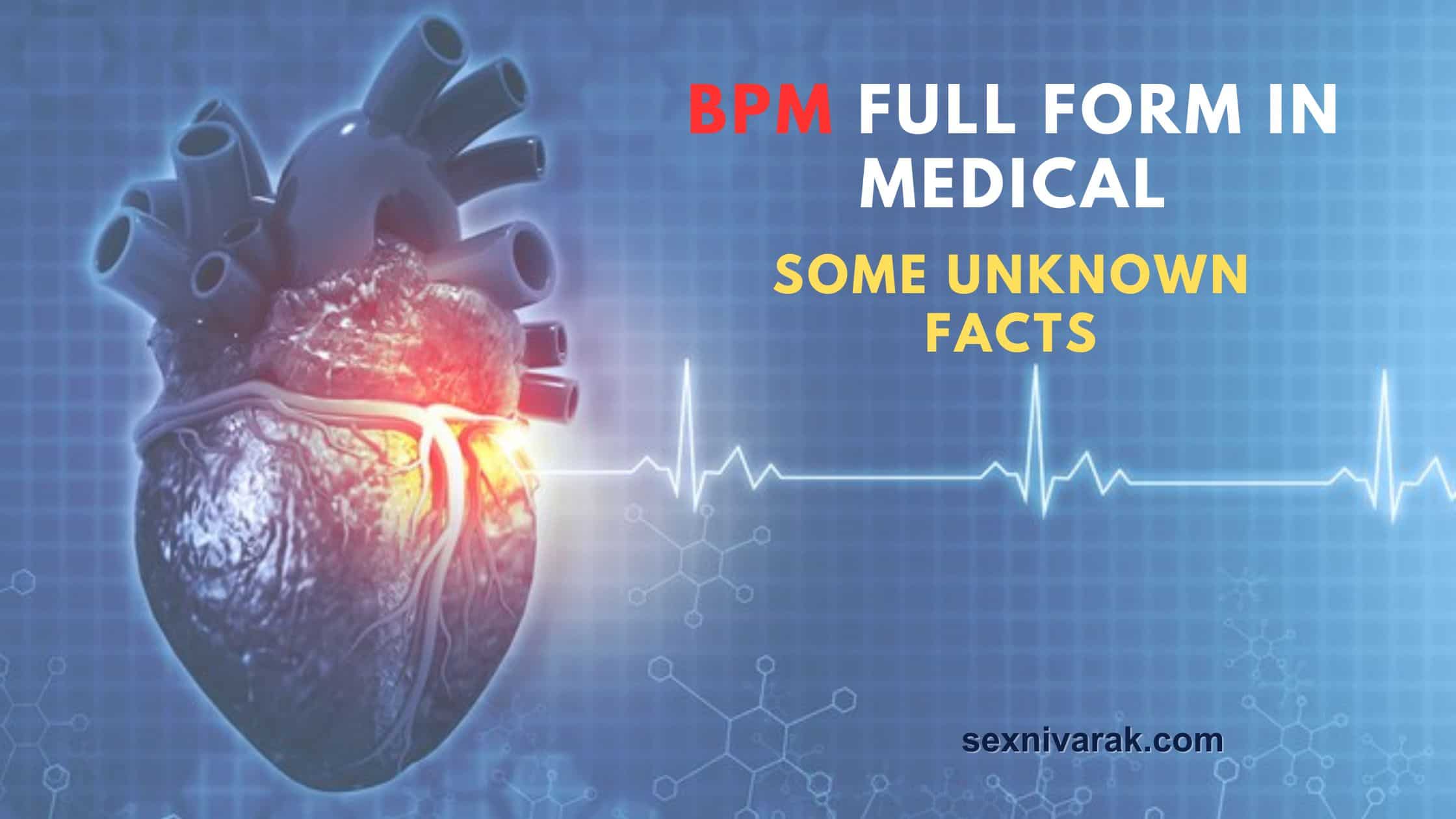BPM is a measure of the heart rate or pulse rate, it signifies the number of times the heart beats in a minute. BPM Full Form in Medical Terms stands for Beat Per Minute. BPM is an essential sign that is used to evaluate an individual’s cardiovascular health and can provide extravagant information about their overall well-being.
A healthcare professional typically checks the pulse at certain arterial points of the body, such as the wrist (radial artery) or the neck (carotid artery) to measure BPM. In substitute, some specialized medical devices can provide you with accurate and continuous BPM readings with the help of heart rate monitors or electrocardiogram (ECG) machines.
BPM gives you out as a crucial indicator of the heart’s performance and can help diagnose various medical conditions. Normal resting BPM for adults is typically between 60 to 100 beats per minute, but it totally depends on some factors such as age, physical fitness, and underlying health conditions.
Observing BPM is particularly important in a situation where during exercise, surgery, anesthesia administration, or when assessing cardiac function. The fluctuation from the normal BPM range can be a result of abnormalities, such as tachycardia (elevated heart rate) or bradycardia (low heart rate), which may require further investigation and medical interventions.
Overall, BPM is an important aspect measurement in the medical field, providing valuable information about cardiac function and assisting healthcare professionals in diagnosing and managing various cardiovascular conditions. So Hope you Understand what is BPM and the Full Form of BPM in Medical Terms, now let’s understand in-depth about BPM in Health Industry.
What is Normal BPM?
Normal BPM, or beats per minute, refers to the average range of heart rate frequently observed in healthy individuals at rest. The normal resting BPM for adults is typically between 60 to 100 beats per minute. Therefore, it’s important to notice that individual variations always exist at times, and many factors can influence heart rates, such as age, physical fitness, and overall health.
It’s essential to always remember that heart rate can vary on various factors, including physical activity, stress levels, caffeine or nicotine consumption, medications, and certain medical conditions. Take the advice of healthcare professionals, about your heart rate or if you experience any unusual changes in heart rate patterns.
Monitoring heart rate over time and comparing it to the individual’s baseline can help you to observe any significant departure or abnormalities that may require further considerations and medicals attentions.
There are so many aspects to consider regarding normal BPM like resting heart rate, factors affecting BPM, fitness, age, individual variations, and monitoring & interpretation. Always keep in mind, that while knowing the normal range of BPM is useful, it is equally vital to consider the context of an individual’s overall health, medical history, and specific circumstances when analyzing heart rate measurements. Talk with healthcare professionals, and put forwards your personalized advice and guidance.
How can I use my pulse to check my heart rate?
There are some steps you have to follow when you check your heart rate using a pulse:-
- Find a comfortable position: Sit down in a quiet and relaxed environment. Make sure you are in a comfortable position, with your arm and hand supported, if possible.
- Locate your pulse: You can find your pulse at the radial artery i.e. wrist. Place the index and middle fingers of one hand on the inner side of your opposite wrist, just below the base of your thumb. Make sure you press lightly until you feel a light sensation.
You can also find your pulse at the carotid artery i.e. neck. In that place the index and middle fingers of one hand on the side of your neck, just below your jawline. Press gently until you feel the pulse.
- Count the beats: Once you have located your pulse, count the number of beats you feel within a specific time frame.
- Be consistent and accurate: Be sure that you’re counting the beats accordingly. Start counting from zero, and focus on feeling each individual pulse. Avoid counting your own heartbeats. Use a watch or timer to maintain an accurate count and repeat for accurate measurement.
- Record your heart rate: Keeping track of your heart rate helps to monitor your health.
So, these are the points you should cover if you check your heart rate.
Is there any difference between the heart rate and pulse rate?
The terms ”heart rate” and “pulse rate” are often used interchangeably to refer to the same physiological measurement. Both heart rate and pulse rate represent the number of times the heart beats in a given time frame. However, there is a perfection between these two.
Heart rate specifically refers to the number of times the heart beats in a minute. It is measured in beats per minute (BPM). It usually gets measured by using medical devices such as an electrocardiogram (ECG) or heart rate monitor that directly estimates the electrical activity of the heart.
Whereas, Pulse rate can be felt at various arterial points of the body. It is the steady expansion and compression of an artery that occurs with each heartbeat, resulting in the pulse. It is also measured in beats per minute (BPM) and is commonly assessed by manually feeling the pulse at locations such as the wrist and neck.
In the extract, heart rate is a more definite and specific measurement of the heart’s activity, as it directly measures the electrical signals generated by the heart. On the other hand, pulse rate is a tangible indication of the heart’s activity that can be felt by placing fingers on an artery.
Now we list some heartbeat rates according to the age of individuals
| Age Size | Normal Resting Heart Rate |
| New Born Baby (0 or 1 month) | 70 to 190 bpm |
| Infants (1 to 11 months old) | 80 to 160 bpm |
| Children 1 to 2 years old | 80 to 130 bpm |
| Children 3 to 4 years old | 80 to 120 bpm |
| Children 5 to 6 years old | 75 to 115 bpm |
| Children 7 to 9 years old | 70 to 110 bpm |
| Children 10 years old and teenagers | 60 to 100 bpm |
| Adults | 60 to 100 bpm |
We mention some other full forms of BPM with their categories
| Term | Full Form | Category |
| BPM | Business Process Modeling | Information Technology |
| BPM | Beats Per Measure | Measurement Unit |
| BPM | Blood Pressure Management | Business Management |
| BPM | Background Processing Management | Military and Defence |
| BPM | Business Process Management | Business Management |
| BPM | Blood Pressure Monitor | Measurement Unit |
| BPM | Business Practice Monitor | Business Management |
7 Unknown Facts of Heart you never heard
- Your heart beats over 100,000 times per day.
- Your heart rate changes over time according to your age. (we have already mentioned above)
- Your heart does not make a sound.
- Women’s heartbeat is slightly faster than men’s heartbeat.
- Laughing is good for your heart.
- Heart disease is the number 1 cause of death in the US. therefore, it’s important to take care of your heart by following a heart-healthy lifestyle.
- The right side of your heart pumps blood into your lungs and the left side of your heart pumps blood back through your body.
FAQs
Q1. Is BPM the same as blood pressure?
Ans. No, Bpm is not the same as blood pressure. But both are interrelated to each other. Whereas BPM refers to the number of times the heart beats in one minute. While Blood Pressure refers to the force exerted by the circulation of blood against the wall of blood vessels.
Q2. What is an unsafe heart rate BPM?
Ans. An unsafe heart rate BPM should be taken seriously because they indicate an individual’s health risk. It should remain normal, not to get more high blood pressure or no more low blood pressure. If it does happen you have to consult with a healthcare professional.
Q3. How to calculate pulse rate?
Ans. To calculate your pulse rate, first, you have to find your pulse which is in the location of your wrist and neck. Then use a timer or watch, count the beats. When doing this, remember you have set your timer to accurate, so that it has the possibility to get an accurate result. Repeat your accuracy and record your pulse.
Q4. What heart rate is too high?
Ans. This factor can vary depending on such as age, fitness level, and overall health. Their symptoms like we get fainting, shortness of breath, dizziness, etc.


